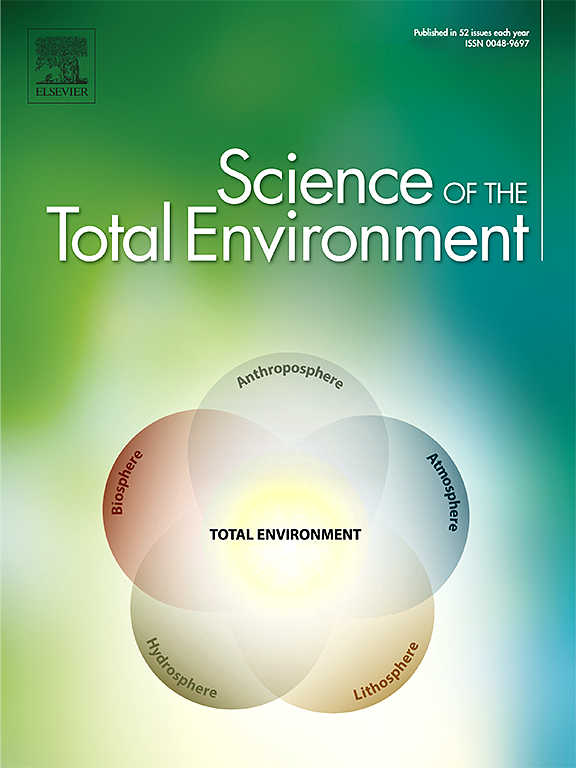A comparative life cycle analysis of Sol-Char and anaerobic digestion sanitation systems
IF 8
1区 环境科学与生态学
Q1 ENVIRONMENTAL SCIENCES
引用次数: 0
Abstract
In this study, we compared the Sol-Char sanitation system with an Anaerobic Digestion (AD) system using Life Cycle Assessment (LCA) to evaluate their environmental impacts. Since both systems offer opportunities for human waste treatment and resource recovery, understanding their performance is crucial. This comparison aims to determine their environmental impacts while considering diverse factors, such as energy production and nutrient recovery. The Sol-Char system demonstrated a superior life-cycle environmental performance, showing two to five times lower impacts in categories such as Climate Change (e.g., 127 kg CO₂-eq for the Sol-Char system while that 592 kg CO₂-eq for the AD system), Non-Renewable Energy Resources, Ionizing Radiation, Land Use, and Water Use. Both systems exhibited significant potential for resource recovery, with the Sol-Char system producing biochar and disinfected urine, and the AD system generating electricity, heat, and digestate. Updated LCA results, after byproduct application, indicated that both systems potentially have a net positive environmental impact (both with reductions exceeding −500 kg CO₂-eq per day). Nutrient recovery simulations using SAmpSONS2 revealed that the AD system performed better when utilizing multiple biomass sources. The nitrogen content in the solids was 20.25 kg/day after AD and 3.75 kg/day for the Sol-Char system. Our results highlight the Sol-Char system is a viable sanitation solution in rural areas. However, the study also identified key challenges, including the absence of uncertainty analysis and the need for a standardized framework that enables more consistent evaluations and comparisons across diverse sanitation systems and contexts.

土壤炭和厌氧消化卫生系统的生命周期比较分析。
在本研究中,我们使用生命周期评估(LCA)来比较Sol-Char卫生系统与厌氧消化(AD)系统对环境的影响。由于这两个系统都为人类废物处理和资源回收提供了机会,因此了解它们的性能至关重要。这种比较的目的是在考虑能源生产和养分回收等多种因素的同时确定它们对环境的影响。Sol-Char系统表现出优异的生命周期环境性能,在诸如气候变化(例如,Sol-Char系统为127 kg CO₂当量,而AD系统为592 kg CO₂当量)、不可再生能源、电离辐射、土地利用和水利用等方面的影响降低了2至5倍。两种系统都显示出巨大的资源回收潜力,其中Sol-Char系统产生生物炭和消毒尿液,AD系统产生电、热和消化。在使用副产品后,最新的LCA结果表明,这两种系统都可能对环境产生积极的净影响(每天减少的二氧化碳当量均超过-500千克)。利用SAmpSONS2进行的养分恢复模拟表明,当利用多种生物质资源时,AD系统表现更好。AD后固体氮含量为20.25 kg/d, Sol-Char体系为3.75 kg/d。我们的研究结果表明,Sol-Char系统在农村地区是一种可行的卫生解决方案。然而,该研究也确定了主要挑战,包括缺乏不确定性分析,需要一个标准化框架,以便在不同的卫生系统和环境中进行更一致的评估和比较。
本文章由计算机程序翻译,如有差异,请以英文原文为准。
求助全文
约1分钟内获得全文
求助全文
来源期刊

Science of the Total Environment
环境科学-环境科学
CiteScore
17.60
自引率
10.20%
发文量
8726
审稿时长
2.4 months
期刊介绍:
The Science of the Total Environment is an international journal dedicated to scientific research on the environment and its interaction with humanity. It covers a wide range of disciplines and seeks to publish innovative, hypothesis-driven, and impactful research that explores the entire environment, including the atmosphere, lithosphere, hydrosphere, biosphere, and anthroposphere.
The journal's updated Aims & Scope emphasizes the importance of interdisciplinary environmental research with broad impact. Priority is given to studies that advance fundamental understanding and explore the interconnectedness of multiple environmental spheres. Field studies are preferred, while laboratory experiments must demonstrate significant methodological advancements or mechanistic insights with direct relevance to the environment.
 求助内容:
求助内容: 应助结果提醒方式:
应助结果提醒方式:


